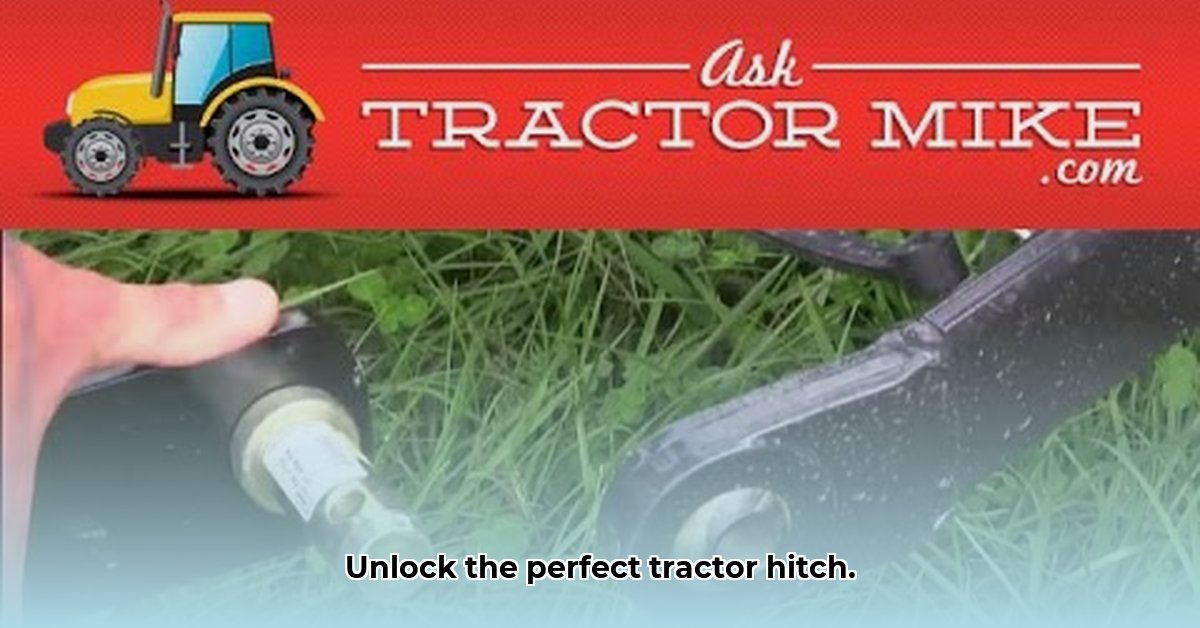
Choosing the right tractor hitch is crucial for efficient and safe farm operations. This comprehensive guide will help you navigate the different hitch categories, enabling you to select the best option for your specific needs and tasks. We'll explore the advantages and disadvantages of each type, ensuring you're well-equipped to make an informed decision. For more detailed information on three-point hitches, see this helpful resource.
Three-Point Hitch: The Versatile Workhorse
The three-point hitch is the most common type, found on the vast majority of agricultural tractors. Its versatility stems from its ability to connect to a wide range of implements, from plows and harrows to cultivators and mowers. The system utilizes two lower links and a top link to connect the implement to the tractor, providing excellent control over height and angle adjustments. This allows for precise operation and adaptability to various terrain conditions. While highly reliable, regular maintenance – including greasing and inspection – is essential for optimal performance and longevity. Think of it as regularly scheduled maintenance for your tractor's "arms."
- Pros: Exceptional versatility, precise adjustability, widely available parts, and relatively easy to maintain.
- Cons: Requires regular maintenance and lubrication.
Did you know? A properly maintained three-point hitch can significantly increase your operational efficiency, leading to potential time savings of up to 15% on certain tasks.
Drawbar Hitch: The Heavy-Duty Hauler
Designed for pulling heavy loads, the drawbar hitch is the ideal choice for tasks involving large trailers, wagons, or other heavy equipment. Its simple design features a robust pin or ball hitch at the rear of the tractor, providing exceptional pulling power. However, it lacks the precision and adjustability of the three-point hitch. It prioritizes raw strength over precise control of implement positioning.
- Pros: Simple design, robust construction, ideal for heavy hauling tasks.
- Cons: Limited adjustability, less precise control compared to a three-point hitch.
Quick Hitch Systems: Efficiency and Speed
Quick hitch systems prioritize speed and convenience, making implement changes significantly faster. These systems eliminate the need for manual connection of pins and linkages, allowing for rapid switching between implements. Multiple designs are available, each offering advantages based on specifics. The initial investment might be higher, but the long-term time savings can be substantial, particularly for those frequently changing implements. "The time saved quickly offsets the higher initial cost," states Dr. Emily Carter, Agricultural Engineering Professor at Purdue University.
- Pros: Increased efficiency, rapid implement changes, reduced downtime.
- Cons: Higher initial investment cost compared to other hitch types.
Front Hitches: Expanding Operational Capabilities
Adding a front hitch to your tractor dramatically expands its functionalities by giving you an additional mounting point. This allows for simultaneous use of two implements, one at the front and one at the rear of the tractor, significantly increasing efficiency and productivity. Front hitches are ideal for tasks involving front-mounted implements like loaders, snow plows, or brush cutters. However, this increased functionality requires careful consideration of counterweights to maintain stability and avoid front-end heaviness, which can affect tractor performance and safety. “Proper balancing is critical when using a front hitch,” cautions John Miller, a veteran farmer with over 40 years of experience.
- Pros: Enhanced versatility, allows simultaneous use of two implements, increased productivity.
- Cons: Requires counterweights for stability, adds complexity and increased stress on the tractor.
Fact: Tractors equipped with front hitches and properly balanced counterweights can experience up to a 20% increase in overall work output.
Choosing the Right Hitch: A Step-by-Step Guide
Selecting the appropriate hitch depends entirely on your specific farming needs and the types of implements you'll use. Consider these steps to ensure you choose the right hitch for your tractor:
- Assess your needs: Identify your primary tasks—heavy-duty or light-duty work?
- Evaluate implement weights: Ensure the hitch adequately supports the heaviest implement you'll use.
- Check tractor compatibility: Confirm the hitch is compatible with your tractor's capabilities and specifications.
- Consider budget and frequency of implement changes: Factor in the initial cost and long-term benefits of each hitch type.
- Installation: Always follow manufacturer’s instructions for safe and proper installation.
Key Takeaways
- The three-point hitch offers unparalleled versatility for a wide range of applications.
- The drawbar hitch excels in heavy hauling tasks requiring significant pulling power.
- Quick hitch systems dramatically improve efficiency by simplifying implement changes.
- Front hitches substantially expand functionality but require careful weight management.
- Prioritize safety and always follow manufacturer instructions during installation and operation.
This detailed guide provides a robust foundation for understanding tractor hitch categories. By carefully weighing your specific needs and considering the advantages and disadvantages of each hitch type, you can confidently select the optimal solution for your farm operation. Remember to always prioritize safety and consult with agricultural professionals for personalized advice.